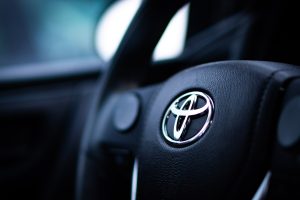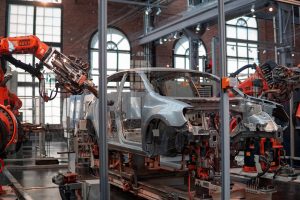8.1 Defining Aggregate Expenditure
Aggregate expenditure is the current value of all the finished goods and services in the economy.
It is the sum of all the expenditures undertaken in the economy by the factors during a specific time period. The equation for aggregate expenditure is:
[latex]\text{AE}=\text{C}+\text{I}+\text{G}+\text{NX}[/latex]
The equation is: aggregate expenditure equals the sum of the household consumption ([latex]\text{C}[/latex]), investments ([latex]\text{I}[/latex]), government spending ([latex]\text{G}[/latex]), and net exports ([latex]\text{NX}[/latex]).
- Consumption ([latex]\text{C}[/latex]): The household consumption over a period of time.
- Planned investment ([latex]\text{I}[/latex]): Planned spending on capital goods.
- Government expenditure ([latex]\text{G}[/latex]): The amount of spending by federal, state, and local governments. Government expenditure can include infrastructure spending, which increase the total expenditure in the economy.
- Net exports ([latex]\text{NX}[/latex]): Total exports minus the total imports.
The aggregate expenditure determines the total amount that firms and households plan to spend on goods and services at each level of income.
The aggregate expenditure is one of the methods used to calculate the total sum of all the economic activities in an economy, also known as the gross domestic product (GDP).
Actual vs Planned Investment
Recall from Chapter 4 that the investment component of GDP includes business fixed expenditures (such as a business purchasing new machinery, new vehicles, building a new factory, etc.), new residential construction, and inventory changes. A change in inventory occurs either when a company produces a product but does not sell it (causing an increase in inventory) or when a company sells a previously unsold good (causing a decrease in inventory). When a company decides on how much to spend on investment, we assume they are making a decision about business fixed expenditures. Therefore, we assume that the amount companies plan to spend on things like machinery and other physical capital will equal what they actually spend. An unexpected change in inventories will cause the difference between actual and planned investments.
Example

For example, suppose that Toyota produces 125,000 Tundra pick-up trucks. If they sell all of them, then there will be no change in inventory. But, if they only sell 100,000 Tundra pick-up trucks, those 25,000 trucks are added to inventory and result in an unexpected increase in investment. Therefore, inventory changes depend on actual sales, which can not always be accurately predicted. Using the above example, we call the production of 125,000 trucks as the actual investment spending and the sale of 100,000 trucks as the planned investment spending.
When actual investment spending (i.e. 125K trucks) exceeds planned investment spending (i.e. 100K trucks), we see an unexpected increase in inventories. This may not be a good sign for an economy because producers will cut production as sales are falling, which may result in some job losses. Conversely, when actual investment spending is less than planned investment spending, we see an unexpected decrease in inventories. That is, Toyota produces 125,000 pick-up trucks but they sell 130,000 trucks because people want to buy more, then we call the production of 125K trucks as the actual investment spending and the sale of 130K trucks as the planned investment spending. When actual investment spending is less than the planned investment spending, it implies a decrease in inventories. So Toyota would ramp up production to restock the depleted inventories which could result in job growth.
As we continue to discuss the aggregate expenditure model, investment will refer to the planned investment rather than the actual investment.
Equilibrium
A macroeconomy will be in equilibrium when
[latex]\text{Aggregate expenditure}=\text{GDP}[/latex]
This occurs when what is being produced equals what is being sold.

When aggregate expenditure is greater than GDP, spending is greater than production. When this occurs, an individual store may realize that a product is being purchased faster than they can order a new product. A company would then recognize that new orders exceed their current production and may need to dip into existing inventories to fulfill orders. As Toyota realizes this, they will ramp up production and increase employment. If this occurs throughout an entire economy, then GDP will begin to increase as companies work to increase their production. Therefore, when aggregate expenditure is greater than GDP, inventories will decline, forcing companies to ramp up production to meet the now greater expenditures. This will lead to an increase in both real GDP and employment.
When aggregate expenditure is less than GDP, spending is less than production. When this occurs, an individual store may realize that the product is not moving quickly off the shelves. As the store realizes this, they start to order less from their distributor. For example, if Toyota is barely selling any cars and continues to produce them, then dealership lots will be full, and there will be nowhere to deliver the cars. This leads to an increase in inventory. As Toyota realizes this, they will slow down production, which will result in a reduction in employment as well. If this occurs throughout an entire economy, then GDP will begin to decrease as companies work to slow their production. This will lead to a decrease in both real GDP and employment.
Fig 8.2 summarizes the three possibilities.
| When, | Then, | Therefore, |
|---|---|---|
| Aggregate expenditure = GDP | Inventories remain the same | The macroeconomy is in equilibrium. |
| Aggregate expenditure > GDP | Inventories shrink | GDP and employment will increase. |
| Aggregate expenditure < GDP | Inventories increase | GDP and employment will decrease. |
Attribution
"Chapter 9: The Aggregate Expenditure Model" in Introduction to Macroeconomics by J. Zachary Klingensmith is licensed under a Creative Commons Attribution-ShareAlike 4.0 International License.

